 = 6x + 2
= 6x + 2
Differentiate all adding terms sequentially, and add the results
together.
Examples
1. y = 3x2 + 2x + 7,
 = 6x + 2
= 6x + 2
2. p = 9m - 2m3,  = 9 - 6m2
= 9 - 6m2
3. y = mx + c,  = m (as we saw before).
= m (as we saw before).
4. φ = 14λ2 -  + λ3
+ 3,
+ λ3
+ 3,  = 28λ - 2λ9
+ 3λ2
= 28λ - 2λ9
+ 3λ2
5. p(T) =  (at constant n, R, V),
(at constant n, R, V), 
Negative powers of x
Recall that we can have negative powers of x as well, i.e.
x-1 =  , x-2
=
, x-2
= 
and in general, x-n = 
These, too, obey the general 'magic' formula:
Examples
1. y =  = 5x-1,
= 5x-1,
 = -5x-2 = -
= -5x-2 = -

2. y =  = 3x-2
-
= 3x-2
-  ,
,  = -6x-3 +
= -6x-3 +  = -
= - 
3. V(r) = - (= the potential between
2 electrons at a separation of r)
(= the potential between
2 electrons at a separation of r)
 =
=  (= the
force of repulsion between them - the famous inverse square law)
(= the
force of repulsion between them - the famous inverse square law)
Roots - Fractional powers of x
Square roots, cube roots, fourth roots, etc., can all be
represented as fractional powers of x.
e.g.  = x½ ,
= x½ ,  = x1/3
= x1/3
 = x2/3 ,
1 /
= x2/3 ,
1 /  = x-½
= x-½
 = (x + 1)½ , 1 /
= (x + 1)½ , 1 /  = (x2 + 3)-1/3
= (x2 + 3)-1/3
These, too, obey the magic formula.
Examples
1. y =  = x½ ,
= x½ ,  = ½ x-½ =
= ½ x-½ = 
2. y =  = x2/3
,
= x2/3
,  =
=  =
= 
3. y = 1 / = x-½ ,
= x-½ ,
 = -½ x-3/2
= -
= -½ x-3/2
= - 
4. φ(λ) =  -
-  = λ½ - 3λ-3/2,
= λ½ - 3λ-3/2, 
Now we have a method to calculate the value of a slope at any
point along a curve, without having to draw the graph and construct
the tangent.
Examples
1. What is the gradient of y(x) = x2
- 4x - 1 at the point x = 4? (Note: this is the
same function we solved graphically, earlier)
Gradient =  = 2x - 4
= 2x - 4
so, when x = 4,  = (24) - 4 =
4 (as we found before)
= (24) - 4 =
4 (as we found before)
2. What is the gradient of y(x) =  + 6 at the point x = 2?
+ 6 at the point x = 2?
 = -
= - 
so when x = 2,  = - ¼
= - ¼
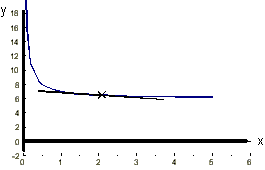
3. What is the gradient of p(q) =  - 2q2 at q = 3?
- 2q2 at q = 3?
 = q2 - 4q,
so when q = 3,
= q2 - 4q,
so when q = 3,  = - 3
= - 3
Zero gradients Turning points, maxima and
minima
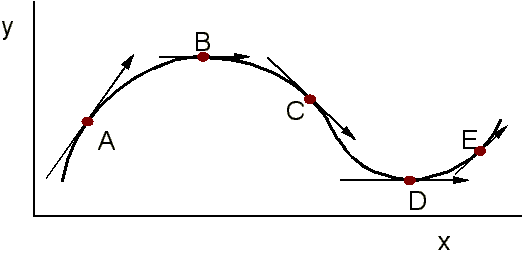
Consider a function which gives a curve like that above. If we
measure the gradient at different points we get different answers:
at points A and E gradient is +ve
at point C gradient is -ve
So at some points in between, B and D, the function
exhibits a stationary value, and this can either be a local
maximum (B) or local minimum(D).
The points at which a curve exhibits a maximum or minimum are
very important in chemistry since this often indicates when the
behaviour of a system changes, shows where an equilibrium position
lies, or shows where something is most (or least) probable.
How do we calculate maxima and minima positions?
We know that at a local max or min, the gradient = 0, i.e.
dy/dx = 0. So, given a function, y(x), all
we need to do is differentiate it, and put the derivative equal
to zero, then solve for x.
Examples
1. y(x) = x3 - 3x + 1
 = 3x2 - 3
= 3x2 - 3
When  = 0, then 3x2
- 3 = 0
= 0, then 3x2
- 3 = 0
3x2 = 3
x2 = 1
x = +/- 1
when x = +1, y = -1
when x = -1, y = 3
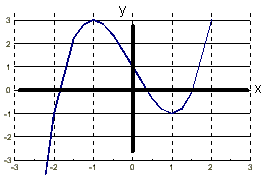
(Note: later we'll show how we tell which is a max and min).
2. y = x2 + 7
 = 2x
= 2x
At stationary point,  = 0,
= 0,
so 2x = 0, i.e. x = 0 and y = 7.
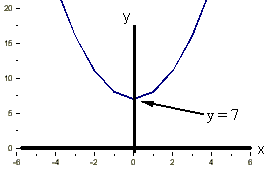
3. The potential V of a diatomic molecule (e.g. Cl2)
can be approximated by a quadratic function of the bond length,
r, of the form:
V(r) = k(r - b)2
[k and b are constants]
What is the equilibrium bond length?
Answer : Multiplying out: V(r) = kr2 - 2kb.r + kb2
The equilibrium position will occur when the potential changes
from attractive to repulsive, i.e. when the slope changes
from +ve to -ve, e.g. at the minimum value of V.
So we need  = 0,
= 0,
 = 2kr - 2kb = 0
= 2kr - 2kb = 0
r = b
So the constant b is actually the equilibrium bond length.
The value of V at which this occurs is V(b) = 0.
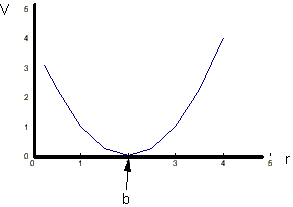
 Next lecture
Next lecture